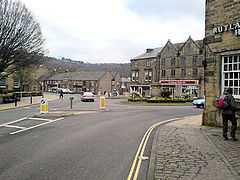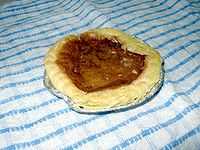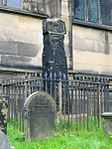Bakewell
| Bakewell | |
 Bakewell Town Centre |
|
 Bakewell | |
| Population | 3,979 (Parish) |
|---|---|
| OS grid reference | SK2168 |
| Civil parish | Bakewell |
| District | Derbyshire Dales |
| Shire county | Derbyshire |
| Region | East Midlands |
| Country | England |
| Sovereign state | United Kingdom |
| Post town | BAKEWELL |
| Postcode district | DE45 |
| Dialling code | 01629 |
| Police | Derbyshire |
| Fire | Derbyshire |
| Ambulance | East Midlands |
| EU Parliament | East Midlands |
| UK Parliament | Derbyshire Dales |
| |
Bakewell is a small market town and civil parish in the Derbyshire Dales district of Derbyshire, England, deriving its name from 'Beadeca's Well'.[1] It is well known for the local confection Bakewell Pudding (often mistaken for the Bakewell Tart). It is located on the River Wye, about thirteen miles (21 km) southwest of Sheffield, 31 miles (50 km) southeast of Manchester, and 21 miles (34 km) north of the county town of Derby; nearby towns include Chesterfield to the east and Buxton to the west northwest. According to the 2001 Census the civil parish of Bakewell had a population of 3,979. The town is close to the tourist attractions of Chatsworth House and Haddon Hall.
History
Although there is evidence of earlier settlements in the area, Bakewell itself was probably founded in Anglo Saxon times, when Bakewell was in the Anglian kingdom of Mercia. Bakewell Parish Church, a Grade I listed building, was founded in 920 and has a 9th-century cross in the churchyard. The present church was constructed in the 12th and 13th centuries but was virtually rebuilt in the 1840s by William Flockton.[2] By Norman times Bakewell had gained some importance—the town and its church (having two priests) being mentioned in the Domesday Book.
A market was established in 1254, and Bakewell developed as a trading centre. The Grade I listed five-arched bridge over the River Wye at Bakewell was constructed in the 13th century, and is one of the few surviving remnants of this earlier period.[3] A chalybeate spring was discovered, and a bath house built in 1697. This led to an 18th-century bid to develop Bakewell as a spa town, in the manner of Buxton. The construction of the Lumford Mill by Richard Arkwright in 1777 was followed by the rebuilding of much of the town in the 19th century.
Economy
Bakewell attracts many domestic and international tourists. Monday is popular with visitors as the traditional market is held in the town on this day. The cattle market is housed in a new purpose built agricultural centre, across the river from the main part of the town. A medium sized stall market is held in the town centre. There is a picturesque public park, alongside the River Wye, which has its source in nearby Buxton (illus. below). For a town of its size, it has a very large town centre. This is mainly because of the tourist nature of the town.
A major employer within the town is the Peak District National Park Authority, based at Aldern House on the Baslow Road. The National Park Authority is tasked with conserving and enhancing, as well as promoting understanding and enjoyment, of the local area.[4] Opposite Aldern House is another major employer, Newholme Hospital, an NHS cottage hospital providing outpatient clinic services to the local community. A campaign in the town, involving local tradespeople, has sought to prevent the establishment of a branch of Costa Coffee in the town.[5]
Landmarks and geography

All Saints Church is a Grade I listed church founded in 920, during Saxon times and the churchyard has two 9th-century Saxon crosses. During restoration work, in the 1840s, many carved fragments of Saxon stonework were found in and around the porch, as well as some ancient stone coffins.
One cross is the Beeley Cross, dug up in a field at a disputed location near Beeley and moved for some years to the grounds of Holt House near Darley Bridge. Although only the base and lower part of the shaft survive, it stands over five feet high and is carved on all four faces.[6]
The other cross is the Bakewell Cross, eight feet high and almost complete. It was carved in the 7th or 8th century and shows a number of scenes including one of the Annunciation. This cross may originally have stood at Hassop Cross Roads, although there is no firm evidence for this.[6]
The church contains a selection of cross fragments and carved stones collected by Thomas Bateman and donated to Weston Park Museum in Sheffield before being moved to Bakewell in 1899.[6]
There is a notable alabaster memorial to Sir Godfrey de Foljambe, who acquired the manor of Bakewell about 1350, and his wife Avena.
Villages near Bakewell include Ashford-in-the-Water, Elton, Great Longstone, Monyash, Over Haddon, Sheldon, Rowsley, Pilsley, Youlgreave & Baslow.
Transport
Railway

In 1862, the Manchester, Buxton, Matlock and Midlands Junction Railway opened Bakewell railway station. The line became part of the Midland Railway and later the LMS main line from London to Manchester. John Ruskin objected to what he saw as the desecration of the Derbyshire countryside, all so that "a Buxton fool may be able to find himself in Bakewell in twelve minutes, and vice versa." In return for the Duke of Rutland's permission for the line to pass through his estate at Haddon Hall, the Bakewell station buildings, located on the hillside overlooking the town, are more imposing than a small town might be thought to justify, and the Duke's coat of arms are carved into the stonework. Such pandering to the nobility and landowners, was typical of the time, since their support would be necessary to obtain the Act of Parliament, even though the inconvenient high contour of the railway, which forced the station to be placed out of town, was due to the Duke insisting that the line ran out of sight of Haddon Hall. The station buildings are now used for small businesses, because the line between Matlock and Buxton closed in 1968: most of the trackway has now been designated the Monsal Trail, a quiet motor-traffic-free track for walking, cycling, and horseriding.
"Normal" trains now run from Derby via Ambergate only as far as Matlock, and from Manchester only as far as Buxton. There have been repeated proposals for fully reopening the remaining, Wye Valley, portion of the line, which would run through Bakewell and over the magnificent Monsal Dale viaduct.
Peak Rail, a local preserved railway venture, has shown the way by reopening the line from Matlock to Rowsley, a village that is a few miles to the east of Bakewell near Haddon Hall. Reaching Bakewell is just one of Peak Rail's long-term ambitions, and in order to keep alive the intention for a future return of the railway (under one auspice or another), Derbyshire County Council is currently protecting the trackbed from development, (in order of seeing the old railway station fully restored and return to its former glory and use, as it still remains completely intact).
Bakewell pudding


Bakewell pudding is a jam pastry with an egg and ground almond enriched filling. It is not to be confused with Bakewell tart, which is a completely different confection, made with shortcrust pastry, an almond topping and a sponge and jam filling; Mr Kipling also made "Cherry Bakewells", often also known as Bakewell tarts. The origins of the pudding are not clear; however, the generally accepted story is that it was first made by accident in 1820 when the landlady of the White Horse Inn (now called the Rutland Arms Hotel) left instructions for her cook to make a jam tart with an egg and almond paste pastry base. The cook, instead of stirring the eggs and almond paste mixture into the pastry, spread it on top of the jam.[7] When cooked the jam rose through the paste. The result was successful enough for it to become a popular dish at the Inn, and commercial variations, usually with icing sugar on top, have spread the name.[8]
Three shops in Bakewell offer what they each claim is the original recipe. The Bakewell Tart Shop & Coffee House sells four different variations of the confection, including: "Bakewell Tart", "Iced Bakewell Tart", "Moist Bakewell Tart" and "Traditional Bakewell Pudding";[9] whilst The Old Original Bakewell Pudding Shop and Bloomers of Bakewell both sell a "Bakewell Pudding".[10][11]
Events
There are a number of annual events that take place in the town. The Peak District traditional "well dressing" takes place during June in which colourful images made of petals embedded into clay appear at several places throughout the town. The Bakewell Agricultural Show (the Little Royal) is one of the largest covered agricultural show in the UK, and attracts around 65,000 visitors.[12] It takes place on the first Wednesday and Thursday in August at the Bakewell Showground. August also has the Bakewell Arts Festival — a music and theatre event that started in 1997. The Peak Literary Festival is held in the Spring and Autumn of each year. The Spring festival starts on the last Friday in May and the autumn on the last Friday in October. Carnival week, culminating in a procession through the town, is held at the beginning of July.[13]
Sport and recreation
Rugby union is played regularly in the town by Bakewell Mannerians RUFC who currently compete in Midlands 2 East (North).[14]
The town is represented by two football teams Bakewell Red Lion FC and Bakewell Town FC both compete in the Hope Valley Football League.
Bakewell has a large recreation park to the east of the town centre, which has tennis courts, children's playground, and football/cricket pitches. In the town itself, and located near to the library, is the municipal swimming pool and gym.
Stephen Downing case
Bakewell was the focus of attention during the Stephen Downing case, which was also known as the "Bakewell Tart" murder. The case involved the conviction and imprisonment in 1974 of a 17-year-old council worker, Stephen Downing, for the murder of a 32-year-old legal secretary in Bakewell cemetery. Following a campaign by a local newspaper, his conviction was overturned in 2002, after Downing had served 27 years in prison. The case is thought to be the longest miscarriage of justice in British legal history,[15][16][17] and attracted worldwide media attention.[18]
In literature
Bakewell is mentioned by Elizabeth Bennet as the town from which she travelled to visit Pemberley, in ch. 43 of Jane Austen's Pride and Prejudice.
On television
- Bakewell features in the last episode of Most Haunted: Midsummer Murders. In the episode the team investigates a murder which took place in the 1800s on Christmas Eve. It was also crowned the scariest most haunted live episode ever, as the corpses of two unknown men buried in soil were found.
- In 2010 the Rutland Arms Hotel featured in an episode of "The Hotel Inspector".[19]
Geography
 |
Ashford-in-the-Water | Eyam & Hope Valley | Chatsworth House & Baslow |  |
| Macclesfield & Buxton | |
Chesterfield | ||
| ||||
| | ||||
| Hartington | Youlgreave & Derby | Matlock |
Picture gallery
-

River Wye park, with view of five-arch, 13th-century bridge
-

Bakewell Cross, in the churchyard of Bakewell Parish Church
-

thumb|Bakewell Parish Church
References
Notes
- ↑ Roy Millward & Henry Wardle Robinson, The Peak District (Eyre Methuen, 1975)
- ↑ English Heritage (1951) Church of All Saints. Images of England (Retrieved 22 January 2006—free registration required).
- ↑ English Heritage (1951) Bridge. Images of England (Retrieved 22 January 2006—free registration required).
- ↑ "The work of the Authority - Peak District National Park Authority". Peak District. Archived from the original on 29 October 2009. Retrieved 17 October 2009.
- ↑ Alexandra Topping "Bakewell unites around tarts to fight off Costa Coffee", The Guardian, 1 February 2013
- ↑ 6.0 6.1 6.2 Neville T. Sharpe, Crosses of the Peak District (Landmark Collectors Library, 2002)
- ↑ "Rutland Arms Hotel Bakewell". Rutlandarmsbakewell.com. Retrieved 15 December 2009.
- ↑ "Mr Kipling Cherry Bakewell tart". Britishdelights.com. Retrieved 15 December 2009.
- ↑ "Bakewell Tart Shop website". Bakewelltartshop.co.uk.
- ↑ "The Old Original Pudding Company Limited". Bakewellpuddingshop.co.uk. 13 March 2011.
- ↑ "Bloomers Original Bakewell Pudding". Bakewellonline.co.uk.
- ↑ show.org "Bakewell, Derbyshire, England". Bakewell Show. Retrieved 7 April 2011.
- ↑ "Discover Derbyshire and the Peak District". Derbyshire-peakdistrict.co.uk. Retrieved 15 December 2009.
- ↑ Oldfield, Joe (9 September 2012). "Bakewell Mannerians RUFC". Pitchero.com.
- ↑ "The editor, the murder and the truth". New Statesman. 10 March 2003. Retrieved 15 December 2009.
- ↑ "Downing murder conviction quashed". BBC News. 15 January 2002. Retrieved 15 December 2009.
- ↑ "The new injustices:from false confessions to false allegations". Richardwebster.net. 28 January 2002. Archived from the original on 5 November 2009. Retrieved 15 December 2009.
- ↑ "In Denial of Murder". BBC Press Office. 2 February 2004.
- ↑ "Five TV". Five TV.
Bibliography
- Town Without Pity, Don Hale, Century (4 April 2002), ISBN 0-7126-1530-X
- Bakewell: The Ancient Capital of the Peak, Trevor Brighton, Devon Books (Nov 2005), ISBN 1-84114-419-3
- Bakewell, Robert Innes-Smith, Derbyshire Countryside Ltd; 2r.e. edition (Jan 1994), ISBN 0-85100-114-9
External links
| Wikivoyage has a travel guide for Bakewell. |
| Wikimedia Commons has media related to Bakewell. |
- BakewellOnline.co.uk - Dedicated to Bakewell
- Bakewell.co.uk - Supporting the Bakewell community
- Peak District: Bakewell
- BakewellDerbyshire.com
- CressBrook Towns: Bakewell
-
 Chisholm, Hugh, ed. (1911). "Bakewell". Encyclopædia Britannica (11th ed.). Cambridge University Press
Chisholm, Hugh, ed. (1911). "Bakewell". Encyclopædia Britannica (11th ed.). Cambridge University Press - Events In Bakewell
- Bakewell in the Domesday Book
- whatsonbakewell.co.uk - Up to date information about Bakewell
| |||||||||||||||||